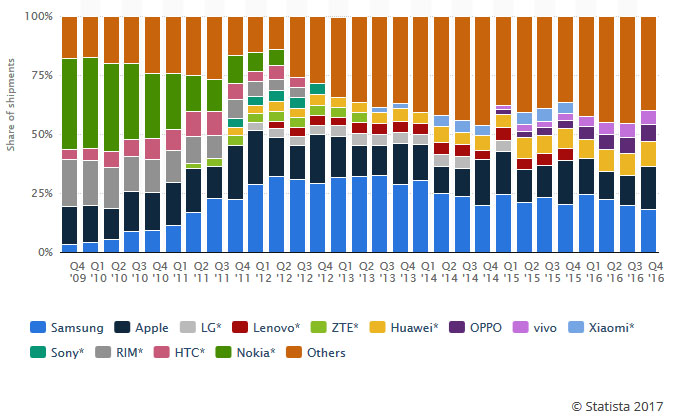Greater than 6 minutes, my friend!
Market share vs translation quality How big smartphone brands predict their future by investing in quality translations
Since I have been in business as a translator I have had the honour to work as a translator for many different manufacturers of smart devices. In those eight years I have seen smartphone brands rising and falling, and witnessed the successes and failures of different marketing campaigns and products. If there is one lesson I have learned, it is that market share and translation quality* are more intertwined than I ever supposed.
Translating for smartphone brands
When starting out as a freelance translator, one of my goals was to pursue famous clients. By working for well-known brands, I thought I would be able to demonstrate the quality of my work. Their commitment to me would in turn grow my business. Since then I have had plenty of chances to work for big brands in different industries. But what I learned was that they often find pricing of more importance than quality. Working for a Fortune 100 company does not necessarily mean that you are a great translator, nor does it guarantee any trust from other companies. I finally came to recognise that my strength as a translator resides in me, not in the brands I work for.
As a tech fan I was nevertheless always seeking to work for the brands I admired for their innovations and ‘shake-up’ potential. However, as with many other brands, working for them was often based on a combination of availability, rates and great test results as well as a bit of reward. Whatever factors made up the breakdown, in the end I was added to core teams and backup teams of different famous smartphone and tablet brands.
Market share by smartphone brand
All smartphone brands have in common that they are continuously seeking new ways to innovate and to gain new market share. In a multi-billion-dollar market where a small failure can result in a large loss of market share, it is always a struggle to survive and find new ways to attract customers. As the image below shows, the competition is fierce with Apple and Samsung on top, but losing ground to competitors.
In the newest roundup of market share analysis IDC calculated that Samsung is still the biggest supplier. However, both companies still seem not to do any more than merely give room or lose ground to each other.
The fight on the smartphone market however, is even more clear if we look to the market developments in the past seven years, the period in which I started to work for smartphone brands. In the image below a remarkable rise and decline of brands in the period from Q4 2009 to Q4 2016 can be seen, and some brands, like Nokia, have even ceased to exist.
A relationship between market share and translation quality
Translators and other industry professionals alike often continue to stress the relationship between translation quality and business success. In some part it seems a compelling way to win customers for their business. There is, however, a real relationship that is often overlooked, if understood at all, by companies who are trying to win new markets but do not want the additional costs of reaching outside of their target audience.
Looking at my experience of translating for some of the leading smartphone brands, I found some striking trends:
- Smartphone brands that did not care about the quality of translations lost a part of their market share, never won market share or even ceased to exist.
- Smartphone brands that cared about the quality of translations are still in the market, losing or winning a little ground.
- Smartphone brands that grew substantially, started investing in QA, QC and other quality measurements.
- Smartphone brands that lose market share are likely to give up on translation quality.
Attention for quality in the translation practice
These are strong conclusions, which are based upon my personal experience. They therefore do not necessarily reflect the experience of other translators. However, these experiences are based upon seven years of working as a translator for at least six smartphone brands, which all show a certain relationship between growth/decline and their demands for quality translations. Of course there can be more reasons for the rise and fall of smartphone brands, like the introduction of an innovative feature or failure to deliver to customer’s expectations. However, as a translator I have seen that an intrinsic drive to quality translations is more common to successful smartphone brands than to smartphone brands that struggle to survive.
No matter the relationship between attention to quality and the growth or decline of a smart device manufacturer, there are a couple of reasons for it.
Willingness to invest in translation quality
Although translation is only a small part of a product offering, it can take up a considerable amount of money. New product introductions, expanding to new markets and customer service in the customer’s native languages require huge investments for which the return cannot be estimated easily. That is why some companies do not consider quality translation very important. For companies trying to win market share, opening a new market and launching products with a flashy campaign is often more important than offering great support in flawless prose. Tech companies and other companies alike often consider translations as a burden on their budget and are not intrinsically motivated to offer great translations. Only if they come to see the importance of dots and commas and start to grow in a certain market will they calculate the costs of great vs poor translations. As long as companies do not consider quality translations a strong asset they will invest only as far as they need to, often paying low prices and attracting not so good translators, and sometimes even non-native translators (I have been part of teams that contained translators that had not mastered the rules of their target languages).
Having the resources to invest in translation quality
In some cases, companies only see the importance of translations after they have opened a new market and are starting to grow. In that case they win the money they need to improve their translations, which can ultimately catalyse their position in the market. The reverse is true as well: companies that are losing market share often cut their investments in translations and translation quality in order to save money. If they have the resources to invest in translation quality they will do it, but if they can apply their resources to other areas of the company they will do that – even if they know the possible consequences for their business.
Understanding the importance of quality translations
Companies are like ordinary people: they only start to understand the importance of language after complaints or great failures. There are only a few companies that have an intrinsic drive to provide great native support from the start of their business. However, that requires a huge budget while it is still uncertain that it will ever pay off. But if companies understand how important it is to take their audience seriously, they will do that in many aspects of their business and marketing campaigns – including translations. It often results in a great customer experience, transforming customers to advocates and growing the market share organically.
In this sense it is also striking that I have not had any request from a translation agency to provide post-editing services for successful smartphone brands. The only smartphone brand I was ever asked to do it for started growing with double digits, found out that the quality of machine translations was poor and stopped short after it had explored the field. Now it invests more in translation quality than many other brands. It seems that smartphone brands still prefer quality human translations above (quality) post-editing translations or machine-only translations. They prefer to invest in translation quality above cutting costs, whatever the consequences might be.
Conclusion
It would be somewhat short-sighted to draw the conclusion that translation quality and market share go hand in hand. The relationship between translations that provide attention to quality, and the market position is nevertheless clear. If companies invest in translation quality assurance they can improve their chances to win. If they don’t, they often struggle to survive. Chances are then that they end up with incorrect translations in their operating systems, poorly spelled user manuals and a negative user experience. Translation quality is the start of a never-ending spiral upwards or downwards and can be the key to the success or failure of a company.
* As it should be common to translators to deliver the best quality possible, with “quality translations” in this article I mean the efforts and money smartphone brands invest in to guarantee a high quality, using translation and editing teams, third party reviewers and internal lead translators and/or quality control departments.









Based on your experience, do you think this advantage coming from translation quality applies to smartphone companies in particular and, if so, why? Does it depend on the type of product?
Hi Eleonora,
I am not sure about that. To me it was striking that some smartphone brands started focusing on translation quality after they grew, while others seemingly laid it aside. For other industries, like automotive and consumer products it is less obvious. I think this has partly to do with the fact that many consumer products, like household applications, should have a manual or so in Dutch, while the manufacturers only see this as something that is needed – not as an asset. In the automotive industry the advantages of technical bulletins and handbooks in a native language are clear, but they are a sort of speaking for themselves – and not regarded as a valuable asset as well.
I see, thank you, Pieter!
OMG, Pieter, you did it again. Another fascinating article. Salutations for having a vision when you started translating several years back: “By working for well-known brands, I thought I would be able to demonstrate the quality of my work.” [I wish I had vision like that.]
I think we should put the affirmation to music (Whitney Houston, Greatest Love of All): ” I finally came to recognise that my strength as a translator resides in me, not in the brands I work for.”
Aside from that, I found the graphs very interesting, displaying mobile phone brands that I have never heard of here in America, like OPPO and ZTE.
Thank you so much for your comment!
Glad you loved it!
I feel with you. Attention is a valuable currency that businesses have to work harder and harder to gain. A well crafted content can help a business grab and keep the attention of their audience. It is about time that content regains it’s rightful central place in the localisation industry.